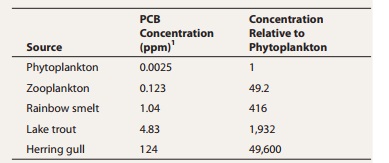Chapter: Basic & Clinical Pharmacology : Introduction to Toxicology: Occupational & Environmental
Environmental Considerations - Toxicology
ENVIRONMENTAL CONSIDERATIONS
Certain chemical and
physical characteristics are important for estimating the potential hazard
involved for environmental toxicants. In addition to information regarding
effects on differ-ent organisms, knowledge about the following properties is
essential to predict the environmental impact: the degradability of the
substance; its mobility through air, water, and soil; whether or not
bioaccumulation occurs; and its transport and biomagnification through food
chains. (See Box: BioaccumulationBiomagnification.) Chemicals that are poorly
degraded (by abiotic or biotic pathways) exhibit environmental persistence and
thus can accumulate. Typical examples of such chemicals include the persistent
organic pollutants (POP) such as polychlorinated biphenyls and similar
substances. Lipophilic substances such as the once-widespread organochlorine
pesticides (eg, DDT) tend to bioaccumulate in body fat, resulting in tissue
residues. Slowly released over time, these residues and their metabolites may
have chronic adverse effects such as endocrine disruption. When the toxicant is
incorporated into the food chain, biomagnification occurs as one species feeds
on others and concentrates the chemi-cal. Humans stand at the apex of the food
chain. They may be exposed to highly concentrated pollutant loads as
bioaccumula-tion and biomagnification occur. The pollutants that have the
widest environmental impact are poorly degradable; are relatively mobile in
air, water, and soil; exhibit bioaccumulation; and also exhibit
biomagnification.
Bioaccumulation & Biomagnification
If the intake
of a long-lasting contaminant by an organism exceeds the latter’s ability to
metabolize or excrete the substance, the chemical accumulates within the
tissues of the organism. This is called bioaccumulation.Although
the concentration of a contaminant may be virtually undetectable in water, it
may be magnified hundreds or thou-sands of times as the contaminant passes up
the food chain. This is called biomagnification.The biomagnification of polychlorinated biphenyls (PCBs) in the
Great Lakes of North America is illustrated by the following residue values
available from Environment Canada, a
report pub-lished by the Canadian government, and other sources.Thus, the biomagnification
for this substance in the food chain, beginning with phytoplankton and ending
with the herringgull, is nearly 50,000-fold. Domestic animals and humans may eat
fish from the Great Lakes, resulting in PCB residues in these spe-cies as well.

Related Topics